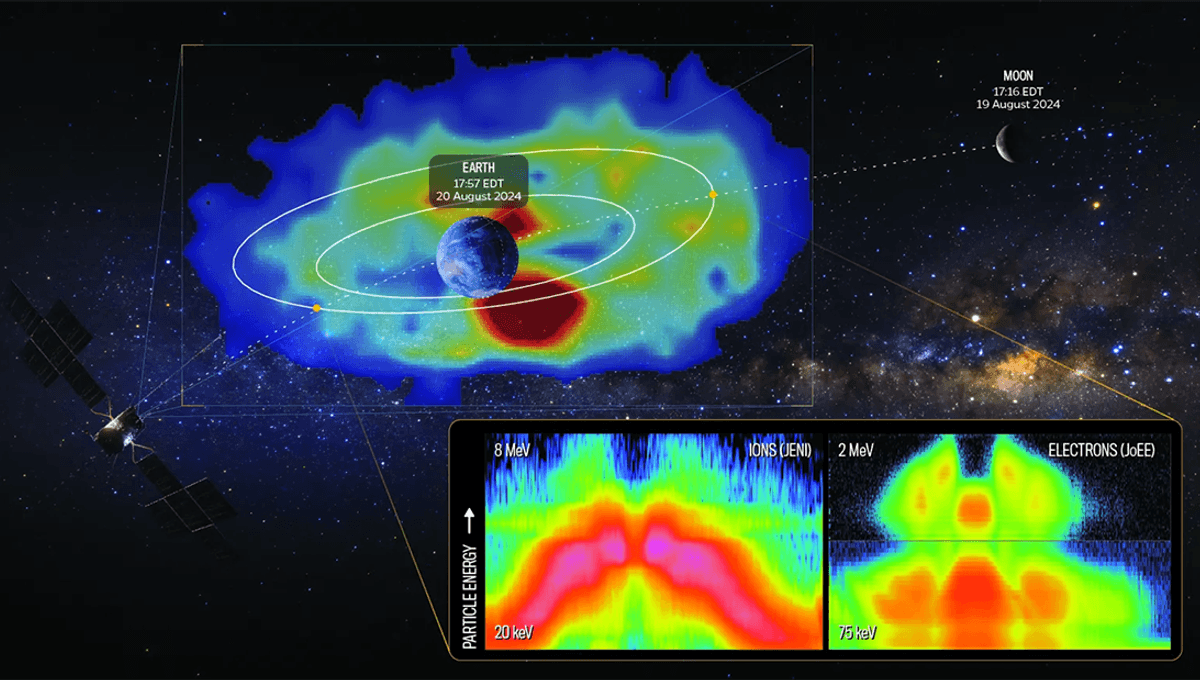
The Jupiter Icy Moons Explorer (JUICE) mission run by the European Space Agency (ESA) has taken the sharpest images ever produced of the Earth’s radiation belt.
JUICE has a long mission ahead of it. Launched in April 2023, the spacecraft has to make several gravitational assists before it reaches its target of Jupiter and three of its largest moons – Ganymede, Callisto, and Europa – including one never-before-attempted maneuver using both the Earth and the Moon.
While performing that maneuver in August 2024, JUICE conducted several tests of its instruments ahead of collecting data on Jupiter’s moons, including one test that detected signs of life on Earth. NASA’s instruments were also put to use during the flyby, including the Jovian Energetic Neutrals and Ions (JENI) instrument, which imaged the Earth as it sped away.
“What it captured is invisible to the human eye,” Patricia Talbert, a member of NASA’s planetary defense team, explains. “Unlike traditional cameras that rely on light, JENI uses special sensors to capture energetic neutral atoms emitted by charged particles interacting with the extended atmospheric hydrogen gas surrounding Earth.”
The result is a stunning look at the Earth’s radiation belts.
Just beyond low-Earth orbit, the planet is surrounded by radiation belts sometimes called the Van Allen belts after astrophysicist James Van Allen who helped figure out how to get through them.
“The Earth’s magnetosphere traps the high energy radiation particles and shields the Earth from the solar storms and the constantly streaming solar wind that can damage technology as well as people living on Earth,” NASA explains.
“These trapped particles form two belts of radiation, known as the Van Allen Belts, that surround the Earth like enormous donuts. The outer belt is made up of billions of high-energy particles that originate from the Sun and the inner belt results from interactions of cosmic rays with Earth’s atmosphere.”
As well as capturing the image, NASA’s JENI and the Jovian Energetic Electrons (JoEE) instrument gathered data on the interaction between the Moon’s surface and the space environment during a 30-minute flyby.
“As soon as we saw the crisp, new images, high fives went around the room,” said Matina Gkioulidou, deputy lead of JENI, in a statement. “It was clear we had captured the vast ring of hot plasma encircling Earth in unprecedented detail, an achievement that has sparked excitement for what is to come at Jupiter.”
That mission is still far from beginning, with the probe still set to make two more flybys of Earth and one flyby of Venus before it arrives at the gas giant in 2031. But with several key instruments up and running, exciting times lay ahead.
Source Link: Sharpest Image Of Earth's Radiation Belt Taken By NASA Shows Hot Plasma Encircling The Planet